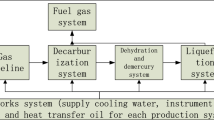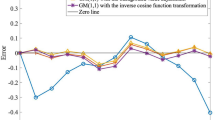Abstract
Stop production and overhaul is an annual work of LNG (Liquefied Natural Gas) plant. However, the shutdown maintenance work under different market conditions needs comprehensive allocation of resources to achieve the purpose of economy, speed and safety. In order to study the fault situation of pneumatic valve, targeted maintenance work is carried out. In this paper, a workflow of DGM(1, 1) prediction model of grey system and sampling inspection method is proposed. With the help of DGM(1, 1) to predict the universality of "poor information and small sample" and the partial detection method of sampling inspection, the expected engineering purpose is achieved. The research results are as follows: (1) The failure situation of pneumatic valve in LNG plant from 2015 to 2020 is brought into the model to compare the actual value and predicted value in 2020, and the residual error is between 0.92 and 3, which indicates that the predicted result of the model is reliable. It is predicted that the comprehensive failure rate will remain at around 18% in 2021 and 2022. Next, we can continue to use DGM(1, 1) model to analyze the redundancy of actuator measurable signals. Make full use of the field known data, construct the functional relationship of measurable variables of actuators, realize on-line real-time judgment of actuator faults, and dynamically predict the failure rate of parts. (2) For maintenance work, 130 pneumatic valves need to be dismantled, with emphasis on the inspection of three components such as drive gas filter, electromagnetic valve and actuator. If the damage number is found to be less than or equal to 4, production can continue after the spare parts are repaired and replaced, otherwise, total inspection is required. In the next step, the relationship between valve distribution position and parts damage frequency should be counted, and the damage frequency should be reduced by strengthening sealing and changing installation methods.





Similar content being viewed by others
Data availability
Not applicable.
References
Abu Arqub O (2015) Reproducing kernel algorithm for the analytical-numerical solutions of nonlinear systems of singular periodic boundary value problems. Math Probl Eng. https://doi.org/10.1155/2015/518406
Abu Arqub O, Singh J, Alhodaly M (2023) Adaptation of kernel functions-based approach with Atangana–Baleanu–Caputo distributed order derivative for solutions of fuzzy fractional Volterra and Fredholm integrodifferential equations. Math Methods Appl Sci 46(7):7807–7834
Abu Arqub O, Singh J, Maayah B, Alhodaly M (2023) Reproducing kernel approach for numerical solutions of fuzzy fractional initial value problems under the Mittag–Leffler kernel differential operator. Math Methods Appl Sci 46(7):7965–7986
Alsmadi O, Momani S, Arqub OA (2013) A genetic algorithm approach for prediction of linear dynamical systems. Math Probl Eng. https://doi.org/10.1155/2013/831657
Chen C-L, Pey-Chung C (1993) A pneumatic model-following control system using a fuzzy adaptive controller. Automatica 29(4):1101–1105
Deenadayalan V, Vaishnavi P (2021) Improvised deep learning techniques for the reliability analysis and future power generation forecast by fault identification and remediation. J Ambient Intell Hum Comput 13:57
Fang L et al (2016) A semi-physical model for pneumatic control valves. Nonlinear Dyn 85(3):1–14
Govindaraju K, Bebbington M, Kissling R (2018) Stringent sampling inspection plans using upper envelopes for cell counts. Food Control 94:30–37
Hildebrandt A, Rüdiger N, Oliver S (2009) Optimal system design of siso-servopneumatic positioning drives. IEEE Trans Control Syst Technol 18(1):35–44
Hsu C-C, Chen C-Y (2003) Applications of improved grey prediction model for power demand forecasting. Energy Convers Manage 44(14):2241–2249
Hu S, Wang H (2018) Nearly optimal truncated group sequential test on binomial proportions. Commun Stat Simul Comput 47(8):2332–2342
Kam TY (2018) Fatigue reliability analysis of mechanical components for airflow control in pneumatic solenoid valve. IOP Conf Ser Mater Sci Eng 397(1):012063
Karpenko M, Sepehri N, Scuse D (2003) Diagnosis of process valve actuator faults using a multilayer neural network. Control Eng Practice 11(11):1289–1299
Khajanchi S (2017) Uniform persistence and global stability for a brain tumor and immune system interaction. Biophys Rev Lett 12(04):187–208
Khajanchi S (2020) Chaotic dynamics of a delayed tumor–immune interaction model. Int J Biomath 13(02):2050009
Malik MK, Singh A, Swaroop A (2022) A planned scheduling process of cloud computing by an effective job allocation and fault-tolerant mechanism. J Ambient Intell Hum Comput 13:1153–1171
Matsui T, Nogami T, Yokoi Y (1995) Failure diagnosis for pneumatic control valves by neural network. In: Proceedings of ICNN'95-international conference on neural networks, vol 2, pp 724–729
Mukherjee A, Kundu PK, Das A (2020) Application of principal component analysis for fault classification in transmission line with ratio-based method and probabilistic neural network: a comparative analysis. J Inst Eng (india) Ser B 101:321–333
Mishra P, Vineet K, Rana KPS (2014) A novel intelligent controller for combating stiction in pneumatic control valves. Control Eng Practice 33:94–104
Mukherjee A, Kundu PK, Das A (2021a) Transmission line fault location using PCA-based best-fit curve analysis. J Inst Eng (india) Ser B 102:339–350
Mukherjee A, Kundu PK, Das A (2021b) Transmission line faults in power system and the different algorithms for identification, classification and localization: a brief review of methods. J Inst Eng (india) Ser B 102:855–877
Mukherjee A, Kundu PK, Das A (2021c) A differential signal-based fault classification scheme using PCA for long transmission lines. J Inst Eng (india) Ser B 102:403–414
Neto AP, Ubirajara FM, Alexandre O (2018) Failure distribution analysis of a novel subsea valve actuator concept based on reliability database. IFAC-PapersOnLine 51(24):1247–1254
Nogami T, Yokoi Y, Kasai M (1993) Failure diagnosis system on pneumatic control valves by neural network. In: IEEE international conference on neural networks. IEEE, vol 3, pp 1876–1881
Padmakumari P, Umamakeswari A (2019) Development of cognitive fault tolerant model for scientific workflows by integrating overlapped migration and check-pointing approach. J Ambient Intell Hum Comput, 1–11
Rajput PK, Sikka G (2021) Multi-agent architecture for fault recovery in self-healing systems. J Ambient Intell Hum Comput 12:2849–2866
Saravanabalaji M, Sivakumaran N, Sankarnaraynan S (2019) Dynamic compensation of acoustic resonance for water flow system. J Inst Eng (india) Ser B 100:405–415
Schmitt R, Sobrinho MRS (2018) Nonlinear dynamic modeling of a pneumatic process control valve. IEEE Lat Am Trans 16(4):1070–1075
Song X et al (2021) A bearing fault diagnosis model based on CNN with wide convolution kernels. J Ambient Intell Hum Comput 1–16
Stamos A, Bruyneel S, De Rock B, Cherchye L (2018) A dual-process model of decision-making: the symmetric effect of intuitive and cognitive judgments on optimal budget allocation. J Neurosci Psychol Econom 11(1):1–27
Thakur AK, Kundu PK, Das A (2021) Prediction of unknown fault of induction motor using SVM following decision-directed acyclic graph. J Inst Eng (india) Ser B 102:573–583
Tylee J (1983) On-line failure detection in nuclear power plant instrumentation. IEEE Trans Autom Control 28(3):406–415
Verma M, Misra AK (2018) Modeling the effect of prey refuge on a ratio-dependent predator–prey system with the Allee effect. Bull Math Biol 80:626–656
Wang T et al (2016) Parameter tuning method for dither compensation of a pneumatic proportional valve with friction. Chinese J Mech Eng 29(3):607–614
Wu J, Rangan S, Zhang H (2012) Green communications: theoretical fundamentals. Algorithms and applications. CRC Press, Boca Raton
Xu N, Dang Y, Gong Y (2017) Novel grey prediction model with nonlinear optimized time response method for forecasting of electricity consumption in China. Energy 118:473–480
Yamashita Y (2006) An automatic method for detection of valve stiction in process control loops. Control Eng Pract 14(5):503–510
Funding
This work was supported by the Science and Technology Research Project of Hubei Provincial Department of Education (Q20171301).
Author information
Authors and Affiliations
Corresponding author
Ethics declarations
Conflict of interest
The authors declare that they have no conflict of interests.
Research involving human participants and/or animals
The authors declare that this project does not involve Human Participants and/or animals in any capacity.
Informed consent
The authors declare that this research does not involve any surveys or participants in any capacity.
Additional information
Publisher's Note
Springer Nature remains neutral with regard to jurisdictional claims in published maps and institutional affiliations.
Main points: 1. A fault prediction method of pneumatic control valve based on DGM(1, 1) model of grey system theory is proposed. 2. After the improvement of the maintenance scheme of pneumatic valves in 2021, the failure data of pneumatic valves in 2022 will be further counted. 3. Using the method of sampling statistics, the rapid maintenance project scheme is obtained.
Rights and permissions
Springer Nature or its licensor (e.g. a society or other partner) holds exclusive rights to this article under a publishing agreement with the author(s) or other rightsholder(s); author self-archiving of the accepted manuscript version of this article is solely governed by the terms of such publishing agreement and applicable law.
About this article
Cite this article
Chen, Y., Qiu, J., Wang, M. et al. Fault prediction of pneumatic valves in an LNG plant by the DGM(1, 1) model. Int J Syst Assur Eng Manag 15, 775–785 (2024). https://doi.org/10.1007/s13198-023-02130-9
Received:
Revised:
Accepted:
Published:
Issue Date:
DOI: https://doi.org/10.1007/s13198-023-02130-9




